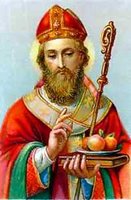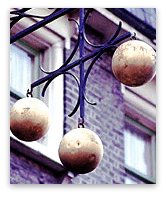St Nicholas

Today is St. Nicholas Day and last night Sinterklaas will have referred to his book that lists all the good and bad children, delivered presents to all the good children and possibly taken the bad children away with him.
The name 'Santa Claus' is a degeneration of the Dutch word Sinterklaas. Saint Nicholas Day is a festivity for children in much of Europe related to surviving legends of the saint, and particularly his reputation as a bringer of gifts.
The historical Nicholas came from Myra in Lycia, Asia Minor and was a 4th century bishop. He is usually depicted wearing his red mantle, his mitre, and his golden crosier and sporting a long, white beard.
Some elements of the Saint Nicholas tradition can be traced back to the Germanic god Wodan (Odin). The appearance is similar to some portrayals of this god. In the Saint Nicholas tradition in the Netherlands he rides a horse over the rooftops, and this may be derived from Odin's riding through the sky. Also his assistants, the Zwarte Pieten ('Black Peters') may be a remnant of the raven that accompanied Wodan. It may also be a reference to African slaves.
The history of the festive Saint Nicholas celebration reflects conflicts between Protestantism and Catholicism. Since Nicholas was a canonised saint, Martin Luther replaced the festival that had become associated with the Papacy with a "Christkind" (Christ child) celebration on Christmas Eve. After the reformation, St. Nicholas's attire began to change, and he started to wear a red suit with fur becoming more reflective of earlier pagan influences.

Saint Nicholas and the three poor maidens,
detail from the Quaratesi Altarpiece,
Gentile da Fabriano, 1425 (Vatican)
detail from the Quaratesi Altarpiece,
Gentile da Fabriano, 1425 (Vatican)
His reputation for gift giving comes partly from a story of three young women who were too poor to afford a dowry for their marriages: as each reached a marriageable age, Nicholas surreptitiously threw a bag of gold into the house at night. Some versions of the legend say that the girls' father, trying to discover their benefactor, kept watch on the third occasion, but Nicholas dropped the third bag down the chimney instead. For his helping the "financially challenged", St. Nicholas is the patron saint of pawnbrokers; the three gold balls traditionally hung outside a pawnshop are symbolic of the three sacks of gold.

Interestingly, he is also patron saint of sailors and thieves, not because pawnbrokers are thieving scum, but because his relics were stolen by sailors from his tomb.
Category: History_






1 Comments:
this post looks aintersting and lonely (no comments) so I've just changed that.
Mind you i may ven read it later!
Speak to you soon.
Goat's cheese.....hmmmmmmmmmmmm
Post a Comment
<< Home